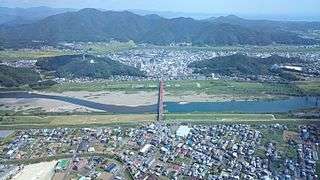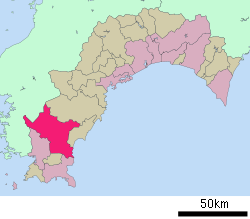Shimanto, Kōchi (city)
Shimanto (四万十市, Shimanto-shi) is a city in southwestern Kōchi Prefecture, Japan. The modern city of Shimanto was established on April 10, 2005, from the merger of the city of Nakamura, and the village of Nishitosa (from Hata District). It is located on the Shimanto River.
Shimanto 四万十市 | |
|---|---|
 View of Shimanto City | |
Flag  Emblem | |
 Location of Shimanto in Kōchi Prefecture | |
%26groups%3D_35b691b95723872c425d12169b673a6b9a532164.svg)
| |
 Shimanto Location in Japan | |
| Coordinates: 33°0′N 132°56′E | |
| Country | Japan |
| Region | Shikoku |
| Prefecture | Kōchi Prefecture |
| Government | |
| • Mayor | Masahiro Nakahira |
| Area | |
| • Total | 632.42 km2 (244.18 sq mi) |
| Population (April 1, 2017) | |
| • Total | 34,433 |
| • Density | 54/km2 (140/sq mi) |
| Symbols | |
| • Tree | Willow |
| • Flower | Wisteria |
| • Bird | Common kingfisher |
| • Fish | Ayu |
| Time zone | UTC+9 (JST) |
| City hall address | 4-10 Nakamura Ōhashi-dōri, Shimanto-shi, Kōchi-ken 783-8501 |
| Website | www |
As of April 1, 2017, the city has an estimated population of 34,433[1] and a population density of 54 persons per km2. The total area is 632.42 km2.
Districts
Shimanto city is divided into thirteen districts.[2]
- Ekawasaki (江川崎地区)
- Gudō (具同地区)
- Higashi-nakasuji (東中筋地区)
- Higashiyama (東山地区)
- Nakamura (中村地区)
- Nakasuji (中筋地区)
- Okawasuji (大川筋地区)
- Shimoda (下田地区)
- Toyama (富山地区)
- Tsuō (津大地区)
- Ushirogawa (後ろ川地区)
- Warabioka (蕨岡地区)
- Yatsuka (八束地区)
The largest district is Nakamura, with a population of 9,352 residents as of November 2013. The smallest is Toyama, with 882 residents.[2]
Geography and climate
Shimanto's population is spread across a large area, broken up by rivers, mountains and uninhabited or sparsely inhabited areas. Both the Shimanto River and the Ushirogawa River run through the city. River levels often rise in summer and autumn due to the rainy season and seasonal typhoons.
Shimanto has a wet subtropical climate (Köppen climate classification Cfa) with hot humid summers and cool to cold winters. Humidity levels are high during the hot summer months. Snow is rare and occurs only once or twice in a year. Rainfall is significant throughout the year, but heavier during the rainy season in June and July, and also in September, when a large number of typhoons hit Japan.
On August 12, 2013, Shimanto recorded a temperature of 41.0 degrees Celsius, the highest ever recorded in Japan.[3]
| Climate data for Shimanto (city) (1981–2010) | |||||||||||||
|---|---|---|---|---|---|---|---|---|---|---|---|---|---|
| Month | Jan | Feb | Mar | Apr | May | Jun | Jul | Aug | Sep | Oct | Nov | Dec | Year |
| Average high °C (°F) | 11.4 (52.5) |
12.8 (55.0) |
15.9 (60.6) |
20.9 (69.6) |
24.6 (76.3) |
27.1 (80.8) |
31.2 (88.2) |
32.1 (89.8) |
29.2 (84.6) |
24.4 (75.9) |
19.1 (66.4) |
14.0 (57.2) |
21.9 (71.4) |
| Daily mean °C (°F) | 5.8 (42.4) |
7.0 (44.6) |
10.2 (50.4) |
15.1 (59.2) |
19.1 (66.4) |
22.4 (72.3) |
26.4 (79.5) |
26.9 (80.4) |
23.9 (75.0) |
18.3 (64.9) |
12.9 (55.2) |
7.7 (45.9) |
16.3 (61.4) |
| Average low °C (°F) | 0.6 (33.1) |
1.6 (34.9) |
4.7 (40.5) |
9.4 (48.9) |
14.1 (57.4) |
18.4 (65.1) |
22.6 (72.7) |
23.1 (73.6) |
19.9 (67.8) |
13.5 (56.3) |
7.7 (45.9) |
2.4 (36.3) |
11.5 (52.7) |
| Average precipitation mm (inches) | 86.4 (3.40) |
114.0 (4.49) |
196.5 (7.74) |
220.9 (8.70) |
260.0 (10.24) |
352.0 (13.86) |
284.8 (11.21) |
329.2 (12.96) |
417.2 (16.43) |
203.6 (8.02) |
131.9 (5.19) |
72.7 (2.86) |
2,669.2 (105.1) |
| Mean monthly sunshine hours | 158.1 | 160.2 | 175.5 | 186.1 | 178.6 | 135.4 | 185.9 | 199.2 | 159.3 | 174.1 | 160.3 | 166.3 | 2,039 |
| Source: Japan Meteorological Agency | |||||||||||||
History
In 1468, Norifusa Ichijo, an aristocrat, fled Kyoto with his family to escape the chaos of the Onin War, which devastated the city.[4][5] He settled in Nakamura, in what is now part of Shimanto.[4] The Ichijo family established a stronghold there, and they modelled Nakamura on Kyoto, giving rise to the nickname of "the little Kyoto of Tosa",[6] Tosa being the former name of Kōchi Prefecture.
Nakamura maintained itself as a small castle town until 1689.[7] In this year, the head of the Nakamura fief was punished for the offence of turning down a post on the Tokugawa Junior Council.[7] The local castle was destroyed, the fief's finances were confiscated, retainers were stripped of their incomes, and the samurai dwellings were destroyed, forcing them to scatter and become farmers or merchants.[7] The Nakamura area lost a great of wealth and independence, and became a minor rural region.[7]
Shimanto was almost entirely destroyed by the 1946 Nankai earthquake.[8] Photographs of the area after the earthquake can be seen in the city museum. The city has since been rebuilt, but very few historical buildings remain.[8]
Tourist spots
Notable people
- Shūsui Kōtoku (1871-1911), radical journalist who played a key role in introducing anarchism to Japan in the early 20th century, executed for treason[7]
- Torahiko Miyahata (1903-1988), freestyle swimmer who represented Japan in the 1924 Summer Olympics[9]
- Mayo Okamoto (1974-), pop singer-songwriter, whose 1995 debut single "Tomorrow" reached number 1 on the Oricon weekly single charts[10]
Sister cities
The following cities were twinned with Nakamura before it became part of Shimanto.
Domestic
References
- "Official website of Shimanto City" (in Japanese). Japan: Shimanto City. Retrieved 1 May 2017.
- http://www.city.shimanto.lg.jp/life/toukei/shimanto/gyousei/h25/11-01/index.html
- "Japan's highest temperature--41 degrees--marked in Kochi Prefecture". The Asahi Shimbun. The Asahi Shimbun Company. 12 August 2013. Archived from the original on 2013-08-13. Retrieved 13 August 2013.
- 小京都 中村の歴史(その3) [The history of Little Kyoto Nakamura (Part 3)] (pdf) (in Japanese). Japan: City of Shimanto. Retrieved 7 December 2013.
- "Nakamura Castle". Japan: the Official Guide. Japan: Japan National Tourist Organization. Retrieved 7 December 2013.
- 小京都 中村の歴史(その1) [The history of Little Kyoto Nakamura (Part 1)] (pdf) (in Japanese). Japan: City of Shimanto. Retrieved 7 December 2013.
- Notehelfer, Frederick George (1971). "Chapter 4: Pacifist opposition to the Russo-Japanese War, 1903–5". Kōtoku Shūsui: Portrait of a Japanese Radical. Cambridge: Cambridge University Press. p. 4. ISBN 978-0-521-07989-1. LCCN 76134620. OCLC 142930.
- "Shimanto city". Let's travel around Japan!. Japan: travel-around-japan.com. 2013. Retrieved 7 December 2013.
- Torahiko Miyahata at Sports Reference
- http://www.mayo-okamoto.com/profile/om/profile/
External links
| Wikimedia Commons has media related to Shimanto, Kochi (city). |
- Official website

